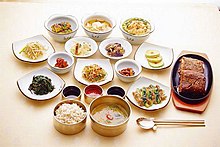 | |
| Type | Hangwa |
|---|---|
| Course | Dessert |
| Place of origin | Korea |
| Main ingredients | grain or other edible seed flour or pollen, and honey |
| Dasik | |
| Hangul | 다식 |
|---|---|
| Hanja | 茶食 |
| Revised Romanization | dasik |
| McCune–Reischauer | tasik |
| IPA | [taɕik̚] |
| This article is part of a series on |
| Korean cuisine 한국 요리 조선 료리 |
|---|
 |
| Staples |
|
AncillariesPickled dishes
Soups & stews |
| DessertsHangwa |
DrinksList of Korean drinks
|
| Condiments |
| Utensils |
| Other |
Dasik (Korean: 다식; lit. "tea food") is a bite-size hangwa that is normally accompanied by tea. It can be made by kneading grain or other edible seed flour or pollen with honey, then pressing them into a decorative mould called dasikpan (다식판). A dasik plate usually consists of an assortment of dasik of different colours, including green, yellow, pink, black, and white. Typical ingredients include: rice flour, pine pollen, black sesame, chestnut, and soybean.
Varieties
- bam dasik (밤다식) – made of steamed and mashed chestnut, or chestnut powder from finely sliced and sun-dried chestnuts
- geomeunkkae dasik (검은깨다식) – made of toasted black sesame seed powder
- kkae dasik (깨다식) – made of toasted sesame seed powder
- kong dasik (콩다식) – made of steamed and pounded yellow soybean
- pureunkong dasik (푸른콩다식) – made of steamed and pounded green soybean
- songhwa dasik (송화다식) – made of pine pollen
- ssal dasik (쌀다식) – made of steamed, dried, toasted, and then pounded glutinous rice flour
Origin
| This section needs additional citations for verification. Please help improve this article by adding citations to reliable sources in this section. Unsourced material may be challenged and removed. (January 2017) (Learn how and when to remove this message) |
Dasik is a food that was introduced to Korea from China during the Song dynasty in China. Dasik became a ceremonial food for weddings during the Joseon dynasty.
Dasikpan
Dasik is shaped with a wooden or porcelain press that forms a patterned confectionery. The press is engraved with a design that forms an embossed pattern on the dasik piece. The design would symbolize the family's name in order to wish for a long life or for a special event, like hwangap or 60th birthday or weddings. Press the dough into a Dasikpan that has letters, flowers or a geometric pattern is embossed. The surface of dasik has letters, flower patterns, or Chinese letters 壽·福·康·寧 representing long life, luck, health and peacefulness. Two dasikpan forms one set. Its length is 30–60 cm, width is 5–6 cm, and thickness is 2–3 cm.
See also
References
- "다식03(茶食)" [dasik]. Standard Korean Dictionary (in Korean). National Institute of Korean Language. Archived from the original on 13 January 2017. Retrieved 11 January 2009.
- Kwon, Yong-Seok; Kim, Young; Kim, Yang-Suk; Choe, Jeong-Sook; Lee, Jin-Young (2012). "An Exploratory Study on Kwa-Jung-ryu of Head Families". Journal of the Korean Society of Food Culture. 27 (6): 588–597. doi:10.7318/kjfc/2012.27.6.588.
- 한국학중앙연구원. "다식" (in Korean). Encyclopedia of Korean Culture.
- Koo Chun-sur Dasik: A Unique Delicacy to Accompany Tea Koreana A Quarterly on Korean Art & Culture web: http://koreana.kf.or.kr/view.asp?article_id=4606&lang=English Archived 2014-12-17 at the Wayback Machine Retrieved on: 7 November 2014